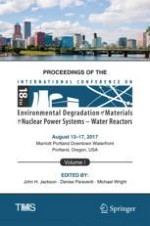2018 | Buch
Über dieses Buch
This two-volume set represents a collection of papers presented at the 18th International Conference on Environmental Degradation of Materials in Nuclear Power Systems – Water Reactors. The purpose of this conference series is to foster an exchange of ideas about problems and their remedies in water-cooled nuclear power plants of today and the future. Contributions cover problems facing nickel-based alloys, stainless steels, pressure vessel and piping steels, zirconium alloys, and other alloys in water environments of relevance. Components covered include pressure boundary components, reactor vessels and internals, steam generators, fuel cladding, irradiated components, fuel storage containers, and balance of plant components and systems.
Anzeige
